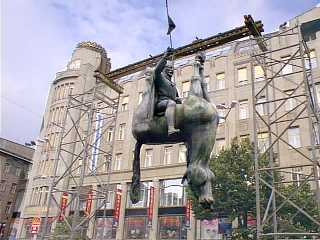 |
Vol 1, No 19
1 November 1999 |
|
|
 K A L E I D O S C O P E:
K A L E I D O S C O P E:Flogging a Dead Horse? Vaclav Pinkava My father's award winning first novel GraveLarks, shortly to be published in English for the first time (extract), starts with a motto from Pushkin's rudely symbolic poem Tsar Nikita, featuring male 'birds' entrapped by female 'nests': The motto (my translation) goes like this: Some folks seem to be detesting Speaking of irreverent comment, of the Czech sense of the absurd, something strange is hovering over Prague's Vaclavske Namesti - Wenceslas Square. David Cerny, the artist who gave us the Pink tank, and the Trabant on legs, (symbolising the East German exodus of a decade ago), has put up (put down?) a dead horse, hung by the legs from a beam, appropriately enough at the bottom or 'bum' end of Wenceslas Square in Prague, the meeting point of drugdealers and pickpockets. Astride the dead horse, (who seems to be a mare or a gelding, in fact), sits a representation of St Wenceslas, the patron saint of the country. To my 'screwy' eyes he is very definitely modelled on Vaclav Klaus himself. 
To me, a Klaus-lookalike St Vaclav caricature, riding an upside down dead horse is the very essence of the absurd theatre - worthy of the other Vaclav, the playwright-president. Such synergy and contrast between the three Vaclavs has not gone unnoticed before, and has even been quoted in the Czech national daily Lidove noviny, evidently discovered via Britske listy (to which they cited an incorrect weblink) The horse is hung in the opposite direction to his role model, vertically and horizontally. Being dead, and upside down, it is sticking its tongue out at the archetype at the far and top end of the boulevard, so massive, yet elegantly balanced on just two legs. For those who do not know the deep symbolic significance of it all, some local lore and history.
So the rotationally symmetrical arrangement of Cerny's equestrian statue is a contrast and a provocation in more ways than one. It might become the alternative meeting point and wreak havoc in ordinary Burghers' meeting schedules, if it stays up a while. I fear it might be defaced or removed, by the Prague 1 Municipality supporters of good taste and Vaclav Klaus, (provided they share my vision, or read CER - hmmm, that is not a large probability). Meanwhile, the possibilities for interpretation are virtually endless. In some ways this is a self-portrait of the artist, in that he is once again taking advantage of an absurd situation, riding the absurdity to triumph. So far, no graffiti. The petitbourgeois don't express their disapproval that way. But there is plenty of tut-tutting going on. For me, this brings another curious echo and link to my earlier theme here. David Cerny's equestrian construction proudly bears the English title "Object", a seemingly all-too literal translation of the Czech "Objekt", meaning artistic installation. Perhaps it should carry a subtitle for the benefit of passers by. "You don't have to." For passers-by certainly do object, however quietly. And that is perhaps the real point. This is a 'happening', not an installation. It is time to speak up about what 'they' are doing to our heritage and values. Speaking up can sometimes work. Take an example from the far end of the Square. Some years ago the Municipality of Prague 1 attached a brass plaque to the real St Wenceslas Monument, and my opposition to the English translation propelled me to the front page of Lidove noviny, (here, and here in Czech), and the sign got taken down. I objected because the trilingual sign's English portion read "Keep off the statue and the basement". I thought it might stop the cinemagoers from getting into the Metro. My objection was heard. Equally, if you'll excuse another pun, some artistic commentaries are more fundamental than others, and I bow before David Cerny's inspiringly objectionable koan metaphor. However large and unsightly the horse's fundament might be, so close up, this is not a bum work of art. Finally let me tie up a couple of remaining loose strands in this article, to make a decorative bow: On the 'basement' of the statue of St Wenceslas there are still four ugly holes, where the 'educationally disadvantaged' brass plaque used to be. How about putting up a small tribute to Josef Vaclav Myslbek there, Mr Burgermeister, to hide your embarrassment? Vaclav Pinkava, 26 October 1999
|
|
![]()
Copyright (c) 1999 - Central Europe Review and Internet servis, a.s.
All Rights Reserved
 Refugees and Migration
Refugees and Migration